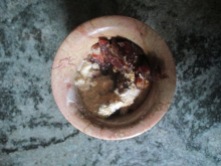Leach of Dates is a dish fit for a banquet table. (No, it’s not that kind of leech!) Naturally sweet from dates, elevated with sugar, scented with rosewater, and spiced with cinnamon and ginger, a tiny bite of this confection is immensely flavorful. In the early decades of the seventeenth century, Leach of Dates would have been served on a delightfully arranged banquet table alongside marchpane, jumbles, nuts, candied fruits, suckets, comfits, and gingerbread.
As Ken Albala writes in The Banquet, “The word [banquet] itself derives from a board or bank mounted by a street performer or mountebank, or set on trestles for dining. Thus banquets could be staged anywhere, because in Renaissance-era Europe, homes lacked a fixed room with stationary tables for dining. The term took an odd twist in England, where it denoted the final portable dessert course of sweetmeats and fruit. Elsewhere it meant an entire meal, the grandest that could be imagined at European courts” (vii). Banquets were feasts for all senses and even the smallest confections were beautifully designed and highly flavorful.
Leach is a thick preserve of fruits that can be molded or sliced. Some recipes include nuts and emulsifying agents to add structure to the confection. As Stephen Schmidt writes in an excellent blog post about banqueting, “There was also a specialized jelly called leach (from a French word meaning slice), which was creamy and rose-water-scented and was set with the new-fangled isinglass, made from sturgeon swim bladders.” The recipe for Leach of Dates relied on the natural viscosity of the dates and bread crumbs for structure, rather than isinglass.
Like my last post about a cure “ffor a cold,” this recipe “To make a Leach of Dates” is from an early seventeenth-century recipe book from the library of Prince Henry Frederick (1594-1612). It was likely created around 1610 and is now held at the Indiana University, Lilly Library. As Schmidt notes, the final pages of this manuscript list “Severall sort of sweet meates fitting for a Banquett” and fruit pastes and jellies form the bulk of this list.
Original Recipe
To make a Leach of Dates.
Take and beate your Dates in a morter
with suger, synamon, ginger, sauders and
rosewater till they bee fine, then putt
in grated bread and beate them together
till it bee thikke and soe serve it forth
in moylde or loves.
After transcribing this recipe, I was left with some questions about “sauders.” On the one hand, this could be a misspelling of “saunders,” a common spelling for sandalwood in the period. Sandalwood was commonly added to sweet, savory, and medicinal recipes in the form of a powder. On the other hand, “sauders” could be connected to isinglass or other emulsifying agents that might help this leach set into a harder paste. Finally, I tested this recipe with Cinnamon Verum. If you’re using Cassia Cinnamon it will taste slightly different. Readers, I would love to hear what you think about “sauders” and if you happen to test this recipe using cassia.
Updated Recipe
4 dates
1 Tablespoon sugar
1/2 teaspoon cinnamon
1/2 teaspoon ground ginger
1 teaspoon rosewater
1 Tablespoon bread crumbs
Remove the pits and stems from the dates. Chop them finely.
Put the chopped dates in a mortar and pestle with the sugar, spices, and rosewater. Beat into a uniform paste. Add bread crumbs and combine until thick.
Shape the paste freeform or using molds.
The Results
Sweet and spicy, the Leach of Dates reminded me of panforte. Each tiny morsel was full of flavor and the scent of rosewater dominated.
I was immediately able to slice the confection into small wedges. I’m planning to check on the Leach in the coming days and see if the texture changes. I anticipate that it will set more as it sits in my kitchen cupboard.
Ultimately, Leach of Dates surprised and delighted me. In the concordia discors of the banquet table, this petite confection invites as much pleasure as an elaborate marchpane sculpture or a prettily arranged plate.
I’ve been thinking about banquets quite a bit in the past weeks as I collaborated on the creation of a performance at Penn State Abington called Exit: A Banquet Piece. I’d like to thank Jac Pryor, for collaborating on this experimental course and performance with me, and I’d like to thank Jonathan Bercovici, Madison Branch, Kyleigh Byers, Jaleel Hunter, Trim Walker, George Ye, and Aman Zabian for inspiration and conversation. As always, thank you to Joseph Malcomson for taste testing and brainstorming.






Sounds very unique.
Thanks, Dorothy!
Hi, Marissa,
The recipe reads ‘delicious.’
I hope you’ll come back with info on what ‘sauders’ is or, at least the thoughts of other readers.
Kathy
Thanks, Kathy! I’m going to continue to investigate.
I would lean towards sauders being an ear-spelling of saudure, as a binder, since it’s more likely that spelling would get the sound more accurate than missing a critical sound letter (also http://www.icwa.org/wp-content/uploads/2015/10/PJW-10.pdf) leads believe that it’s a binder of sort as dates by themselves are only a weak binder, especially if the Leach word origin rings true.
That makes total sense! Saudure implies that the cook should use a binder of their choice. Thank you for thinking this through with me!